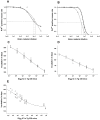Atypical/Nor98 scrapie infectivity in sheep peripheral tissues
- PMID: 21347349
- PMCID: PMC3037359
- DOI: 10.1371/journal.ppat.1001285
Atypical/Nor98 scrapie infectivity in sheep peripheral tissues
Abstract
Atypical/Nor98 scrapie was first identified in 1998 in Norway. It is now considered as a worldwide disease of small ruminants and currently represents a significant part of the detected transmissible spongiform encephalopathies (TSE) cases in Europe. Atypical/Nor98 scrapie cases were reported in ARR/ARR sheep, which are highly resistant to BSE and other small ruminants TSE agents. The biology and pathogenesis of the Atypical/Nor98 scrapie agent in its natural host is still poorly understood. However, based on the absence of detectable abnormal PrP in peripheral tissues of affected individuals, human and animal exposure risk to this specific TSE agent has been considered low. In this study we demonstrate that infectivity can accumulate, even if no abnormal PrP is detectable, in lymphoid tissues, nerves, and muscles from natural and/or experimental Atypical/Nor98 scrapie cases. Evidence is provided that, in comparison to other TSE agents, samples containing Atypical/Nor98 scrapie infectivity could remain PrP(Sc) negative. This feature will impact detection of Atypical/Nor98 scrapie cases in the field, and highlights the need to review current evaluations of the disease prevalence and potential transmissibility. Finally, an estimate is made of the infectivity loads accumulating in peripheral tissues in both Atypical/Nor98 and classical scrapie cases that currently enter the food chain. The results obtained indicate that dietary exposure risk to small ruminants TSE agents may be higher than commonly believed.
Conflict of interest statement
The authors have declared that no competing interests exist.
Figures




References
-
- McKinley MP, Bolton DC, Prusiner SB. A protease-resistant protein is a structural component of the scrapie prion. Cell. 1983;35:57–62. - PubMed
-
- Prusiner SB. Novel proteinaceous infectious particles cause scrapie. Science. 1982;216:136–144. - PubMed
-
- Collinge J, Sidle KC, Meads J, Ironside J, Hill AF. Molecular analysis of prion strain variation and the aetiology of ‘new variant’ CJD. Nature. 1996;383:685–690. - PubMed
-
- Bruce ME, Will RG, Ironside JW, McConnell I, Drummond D, et al. Transmissions to mice indicate that ‘new variant’ CJD is caused by the BSE agent. Nature. 1997;389:498–501. - PubMed
-
- Benestad SL, Sarradin P, Thu B, Schonheit J, Tranulis MA, et al. Cases of scrapie with unusual features in Norway and designation of a new type, Nor98. Vet Rec. 2003;153:202–208. - PubMed
Publication types
MeSH terms
Substances
LinkOut - more resources
Full Text Sources
Research Materials

